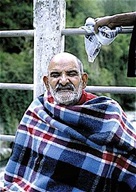Ram Dass (born Richard Alpert; 1931 – 2019), also known as Baba Ram Dass, was an American spiritual teacher, psychologist, and author. His best known book, Be Here Now (1971), has been described as "seminal", and helped popularize Eastern spirituality and yoga with the baby boomer generation in the West. He authored or co-authored twelve more books on spirituality over the next four decades, including Grist for the Mill (1977), How Can I Help? (1985), and Polishing the Mirror (2013).
Dass was personally and professionally associated with Timothy Leary at Harvard University in the early 1960s. Then known as Richard Alpert, he conducted research with Leary on the therapeutic effects of psychedelic drugs (including LSD).
In 1967, Alpert traveled to India and became a disciple of Hindu guru Neem Karoli Baba who gave him the name Ram Dass, meaning "Servant of God".
Neem Karoli Baba or Neeb Karori Baba (c. 1900 – 1973) - known to his followers as Maharaj ji was a Hindu guru and a devotee of Hindu lord Hanuman. He is known outside India for being the spiritual master of a number of Americans who travelled to India in the 1960s and 70s.
Ram Dass tells a story that Baba Lakshman Das boarded a train without a ticket and the conductor decided to halt the train and force Neem Karoli Baba off of the train at the village of Neeb Karori, Farrukhabad district (U.P). After boarding Baba off the train, the conductor found that the train would not start again. After several attempts at starting the train, someone suggested to the conductor that they allow the sadhu back on to the train. Neem Karoli agreed to board the train on two conditions that the railway company promise to build a station at the village of Neeb Karori (at the time the villagers had to walk many miles to the nearest station), and the railway company must henceforth treat sadhus better. The officials agreed and Neem Karoli Baba boarded the train, jokingly saying, "What, is it up to me to start trains?" Immediately after his boarding the train, it started, but the train drivers would not proceed unless the sadhu blessed them to move forward. Baba gave his blessings and the train proceeded. Later a train station was built at the village of Neeb Karori. {A}
Sai Baba of Shirdi (died 15 October 1918), also known as Shirdi Sai Baba, was an Indian spiritual master who is regarded by his devotees to be a manifestation of Sri Dattaguru and identified as a saint and a fakir. He was revered by both his Hindu and Muslim devotees during, as well as after his lifetime.
Sai Baba's disciples and devotees claim that he performed many miracles such as bilocation, levitation, mindreading, materialisation etc..
The ability to levitate was attributed to figures in Early Christianity. The apocryphal Acts of Peter gives a legendary tale of Simon Magus' death. Simon is performing magic in the Roman Forum, and in order to prove himself to be a god, he flies up into the air. The apostle Peter prays to God to stop his flying, and he stops mid-air and falls, breaking his legs, whereupon the crowd, previously non-hostile, stones him to death.
Saint Francis of Assisi is recorded as having been "suspended above the earth, often to a height of three, and often to a height of four cubits" (around 1.3 to 1.8 m).
Levitation has also been cited outside of Christianity. In his book Autobiography of a Yogi, Paramahamsa Yogananda discusses Nagendranath Bhaduri, a saint said to levitate in India.
And Jesus did walk on water.





No comments:
Post a Comment